Electronics
Puffin is in the water and the Outremer team is finishing off the final details to get her ready for handover. In this post I will describe the electronics, communications systems and sailing instruments we have selected.
Choosing a manufacturer
When it comes to instruments and navigation systems for boats there are a lot of choices from many different manufacturers. I chose B&G equipment for Puffin, here’s why:
1. Focus on sailing
We need instruments that perform well offshore in difficult conditions for extended periods. B&G spends a lot of their R&D effort developing products and features for offshore sailing boats. The Volvo Ocean Race boats all use B&G for this reason. If I wanted instruments for a power boat I would look at Raymarine for a similar reason, but for sailing I prefer B&G.
2. Product volume and market share
I don’t want a small manufacturer with a niche focus on say, just racing. It’s difficult to continuously evolve complex, mission critical software when there is a small user base to exercise all the features and identify problems. More software installed in a wide variety of applications ultimately leads to better software products. B&G has a large customer base in the sailing community both in racing and cruising so I’m comfortable with their ability to deliver reliable software, with minimal upgrade issues when moving to new versions.
3. Familiarity with the equipment
I’ve used B&G for many years and I know it well, which makes it easier for me to operate and troubleshoot when there are any issues.
Puffin’s Instrument Package
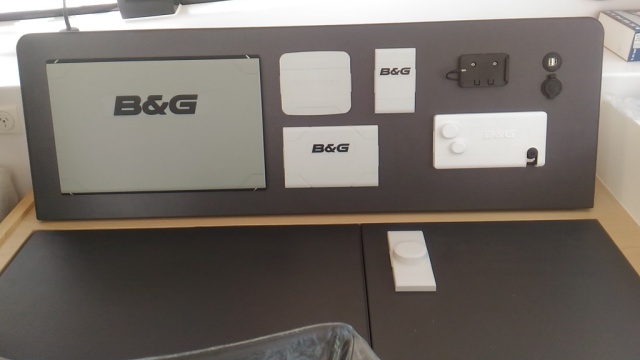
Puffin’s nav station. On the left is a 16″ B&G Glass Helm MFD with a separate UI controller on the desktop. At night I divide the MFD screen in two with the chart plotter and AIS overlay on one side and the radar display on the other. The glass helm gives us more display area for divided screen modes.
Outremer works with Pochon, a marine electronics company that does all of the electronics design and install on Outremer yachts. This was also the case when we built Wildling, and I found it worked very well. Pochon does nothing but electronics, and their staff are all highly trained on the latest equipment. I worked directly with Didier at Pochon on our instrument package and he was excellent. He listened to what I wanted and recommended the best solutions based on not just the manufacturer information, but Pochon’s experience with how the equipment has performed on other boats. We worked through alternatives when there were multiple choices available, and he recommended some things I hadn’t thought of.
The schematic above covers all of the equipment for navigation and sailing. I’ll go through them all by location on the boat. Some of the equipment in the diagram is surrounded by a dashed box which indicates optional. This has to do with what’s included in a standard 4X instrument pack, with the optional items being extra equipment that I added to Puffin. Everything in the diagram is installed on the boat.
Navigation Station
The nav station is one of the primary locations used by on-watch crew to monitor the boat and keep a lookout for traffic. At the nav station we have the 16″ MFD. The MFD gives us access to the auto-pilot control, but I added a dedicated auto-pilot controller because I don’t like having to call up the software pilot controller on the MFD when I am using it for something else. We also have an H5000 display so I can always have important information displayed no matter what the MFD is showing. This would typically be depth wind speed and wind angle. There is a VHF radio at the nav station and a remote VHF station at the port helm. Behind the nav station is our AIS transponder. This is a Vesper XB8000 AIS which is connected to the B&G MFD.
Port Helm
The port helm has an autopilot controller, a 9″ MFD which I find important to have at the helm when anchoring or docking, especially at night. We have the H5000 display same as the nav station, and I have a small Triton display which I leave set to a graphical representation of true and apparent wind speed and angle. This gives me constant, easy to read wind information and frees my other instruments for monitoring boat speed, depth and course. There is also a repeater VHF handset at the helm.
Starboard tiller helm
I use the tiller helm seats all the time when sailing, so I have a set of instruments on the starboard salon bulkhead angled towards the helm chair so they can be easily monitored.
Owner’s Cabin
There is a Triton display in the starboard aft cabin so we can keep an eye on wind, boat speed and depth when off watch.
Mast
On the mast we have the wind sensor, antennas for the VHF, WiFi booster, FM radio and Iridium GO satphone and a mast mounted video camera.
We do a lot of sailing around coral reefs in Australia and the Pacific, so having an aerial view helps a lot when navigating between coral heads. It’s also very useful when anchoring.
The radar dome is mounted on the mast spreader. Since we have a fixed mast there is no issue with the software having to correct for the mast angle when displaying radar targets.
Autopilot
We’re using the Precision 9, 9-axis compass. This is all solid state compared with the flux-gate compass that we had on Wildling. I had some issues with the flux-gate losing its bearing when we were slammed by waves from the side when offshore. I replaced it on Wildling with the Precision 9 and it was fine ever since.
The autopilot is B&G with a hydraulic drive. I haven’t used a hydraulic autopilot before, but Pochon have found them to be very reliable, so I went with their recommendation.
Sensors
In the hull we have the boat speed, depth and temperature sensor, and I added a barometric pressure sensor as well.
Communications
We have a Fusion Stereo which allows media playback via Bluetooth. There are two speaker zones in the salon and cockpit, so we can adjust the volume in each location.
We have a WiFi booster and LTE router which gives us internet access vie either shore WiFi or mobile data networks. The router also allows us to leave a webcam connected to watch the boat remotely.
Satellite Tracking
For tracking we chose the YB3i system from YB Tracking. We had this system on Wildling and it was excellent. Their data plans are very affordable and the system is easy to configure via a smartphone App.
I tried to keep Puffin’s electronics as simple as possible, and included the features we found valuable on our previous boats, plus a few extras that I wished I had in the past. I’ll post an update when we have done some sailing and report on how things are working out.
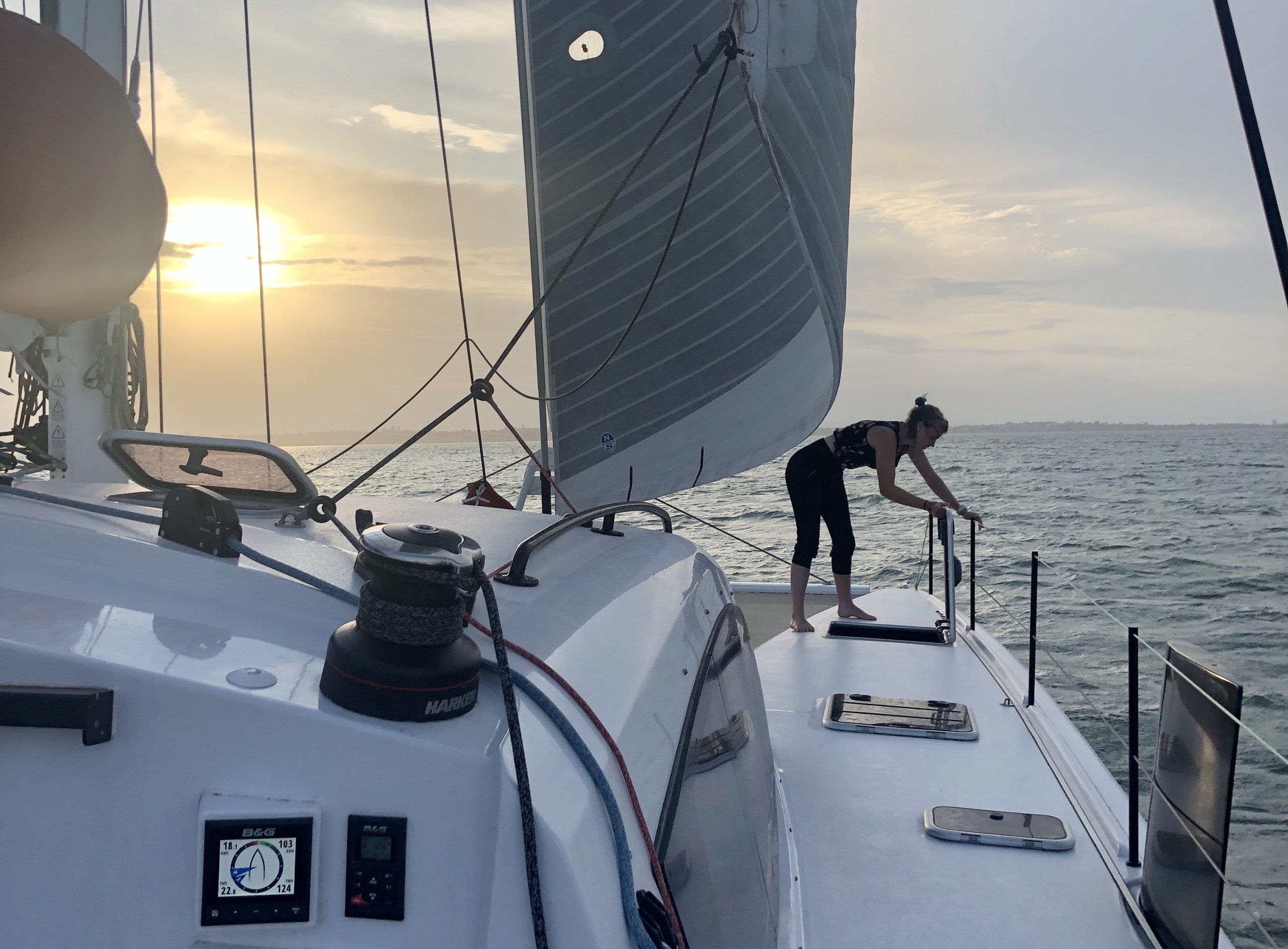

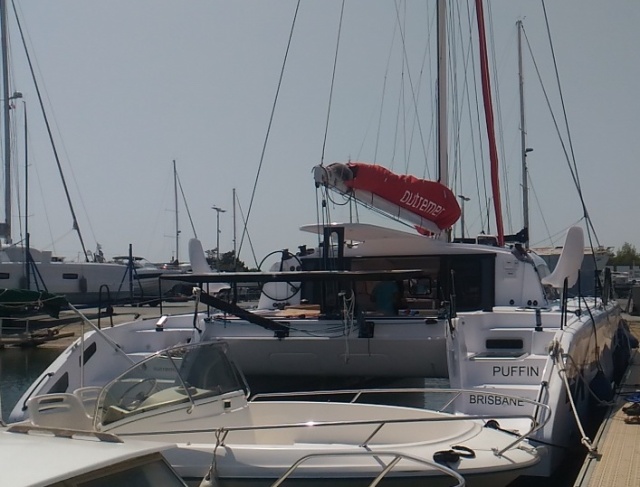

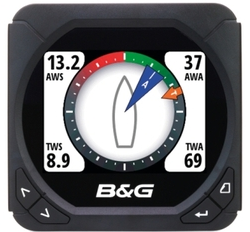


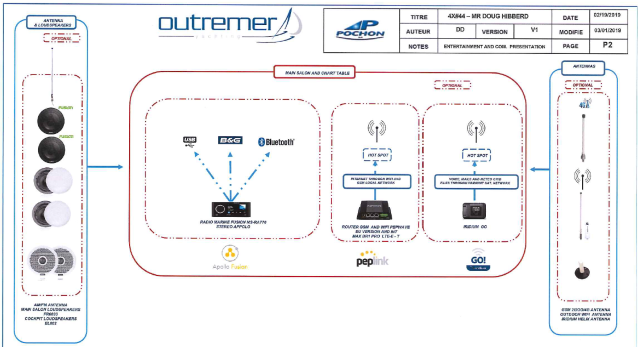
I am building a boat at the moment but coming from a rather novice sailor background and am finding all of your posts so valuable.
LikeLike
Hi Darren, that’s great to hear. Thanks for the feedback!
LikeLike
Hi Doug. Looks like it’s all coming together. I have a question, or rather, curious as to why you opted for the H5000 system versus the much newer NAC3 autopilot system. Basically, do you need all the extra programming parameters provided by the H5000 system?
From what I understand, it can be quite challenging to program and benefit from the numerous extra settings.
I’ve been struggling with this choice for my S/Y albeit a more traditional cruiser/racer with much lower max speed potentials.
Penny for your thoughts
Cheers
Hans
LikeLike
NAC-3 is the computer for B&G Triton instrument systems. It’s lower cost with fewer features. I want the sailing and wind features of H5000 so it’s worth it to me to get the more advanced system.
LikeLiked by 1 person
Curious what your experience with the h5000-powered autopilot has been. I’m having a Balance 526 built, and the b&g rep is really trying to steer us towards the Nac-3 as the h5000 can be a problem if not configured exactly correct. For instance, gust recovery on a cat could be a problem on a cat if not set perfectly. Any thoughts on config now that you’ve been using it?
LikeLike
I’ve honestly never heard that before. I have used H5000 on both my Outremer boats and it has worked perfectly. Setup is very simple and I never experienced any problems with the way our boats handled on autopilot. Not all catamarans have balanced sailplans, particularly in strong winds. In these cases the autopilot will have a hard time managing in gusty conditions. Perhaps the B&G rep is concerned about that? Outremer build well balanced boats, and with the addition of a staysail they handle well under autopilot in strong conditions.
LikeLike
Hi Doug. Just came back from LGM yesterday. Puffin looks even better in reality 😉
Thanks a lot for all the research you did and the excellent posts. It helped a lot finding
the right configuration for our 4X #53. I wish you good luck and fun for the sea trial in
the upcoming weeks and a safe transport of Puffin to Australia.
Cheers
Patrick
LikeLike
Hi Doug,
Was FLIR (forward looking infrared radar) considered in addition to standard radar? Any thoughts on this? Here on the west coast floating/semi-submerged shipping containers are not unheard of.
Enjoyed the launching video; Puffin looks great.
Warmest regards,
Stephen
LikeLike
Hi Dough ,
glad to see you sailing again , and thank you for all the very useful information you give us.
One point fo particular interest is the camera you have fitted on top of the mast (as it
seems according to the photo you display) :could you give us some details, which type is it, cable or wifi connected, polarized filtered lens , remote adjustable angle of view,?
enjoy your sea trial , and much more later !
Patrick Anton
LikeLike
Hi Patrick,
The camera they installed on Puffin is a bit different to the picture I posted. The camera in the picture is zoomed out to a level that’s not very useful. Our camera is a fixed zoom level that shows the forward beam of the boat and an area about 10 meters on each side and about 30 meters ahead. It’s a wired camera, not WiFi. It can be manually adjusted to point further down or further forward. I don’t know about polarization. I am able to see the anchor line in the water quite clearly with the sun in front of us. The real test will be how it does with coral heads. I’ll let you know!
LikeLike
Hi Doug found your blog sear thing for mast mounted camera. I also use B&G. Fill us in how you like it and what it is.
LikeLike
Hi Doug, thanks for the great info. One other question… why did you go with the Vesper AIS instead of the B&G unit? It looks great, but curious if it integrated into the MFD charts as well. Or, do you use it as a separate display over wifi?
LikeLike
The Vesper AIS was recommended by Pochon, the company that does all Outremer navionics design and install, and many other French offshore racing boats as well. Their advice at the time was that the Vesper system was the best available. It integrates completely with the B&G MFDs and has worked flawlessly for us. I had the B&G AIS in Wildling and it was OK too, but I do like that the Vesper system has an external switch at the chart table to allow us to go into stealth mode (receive only) when in dangerous waters.
LikeLiked by 1 person
Hi Doug, Thanks for the great post. I’m new owner of a 2014 Outremer 51 and I’ll be upgrading the navionics. You system looks pretty well thought out. I like the vesper as well. And the camera will be a must have (just returned from Fiji and it certainly would have been useful there!). Now that you’ve had your system on board for a few years, is there anything you’d change? Will the Zeus3S 19″ fit instead of the 16″?
LikeLike